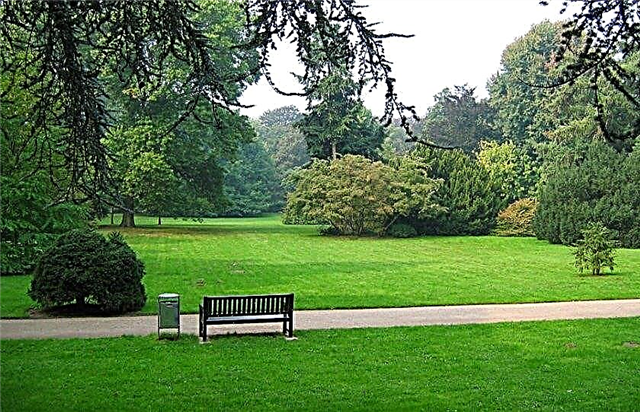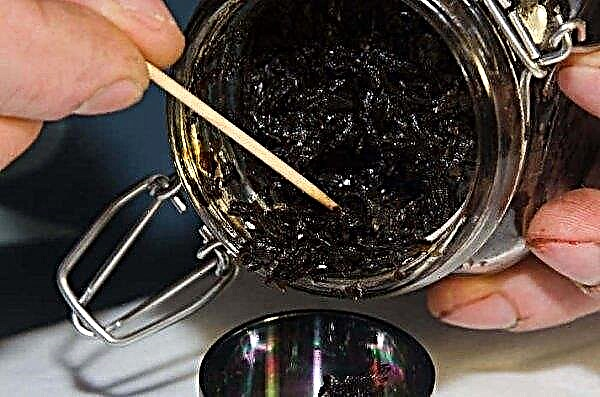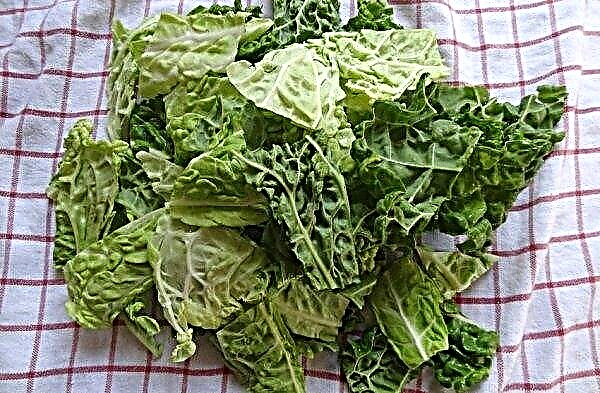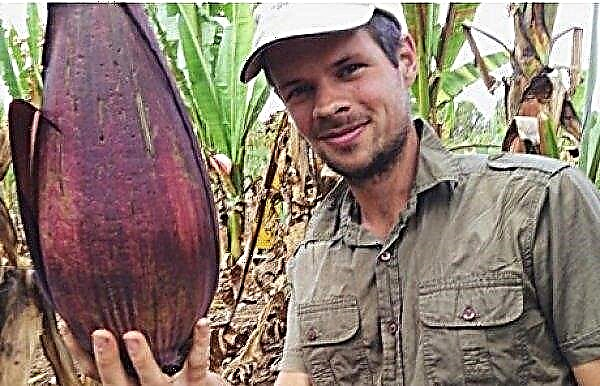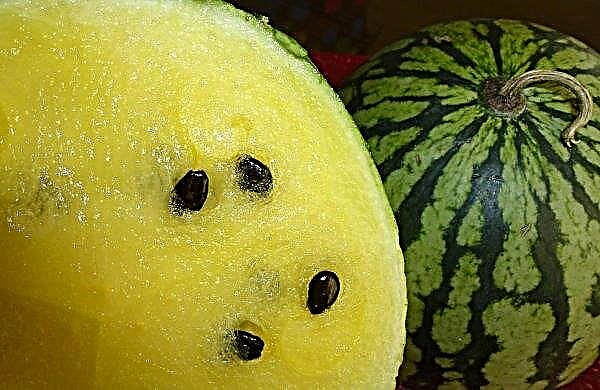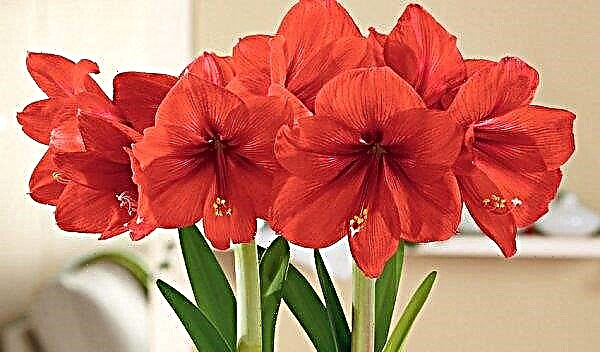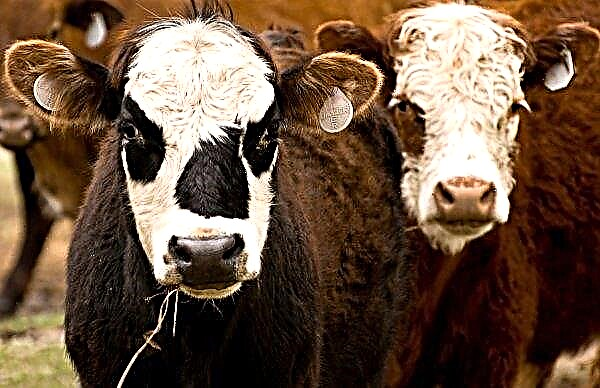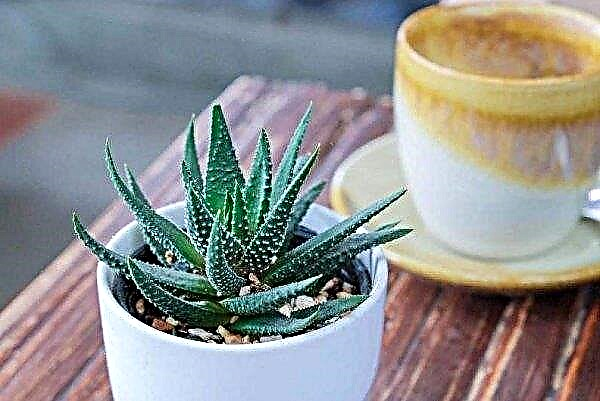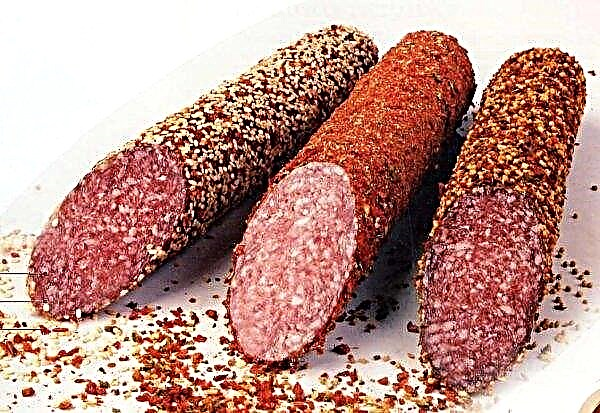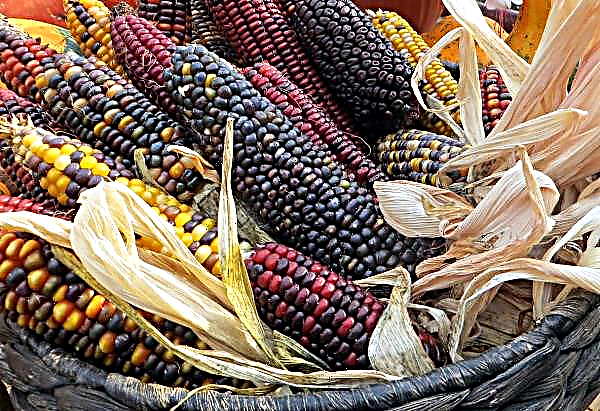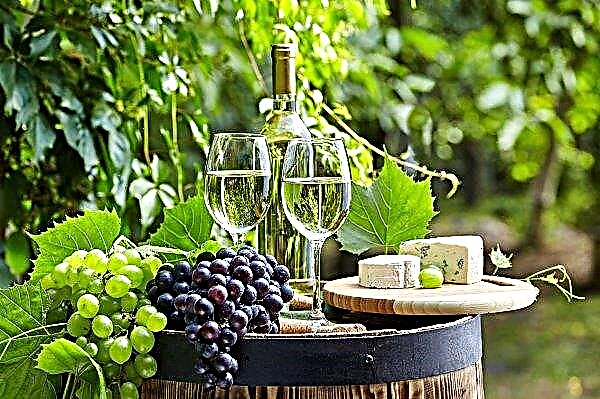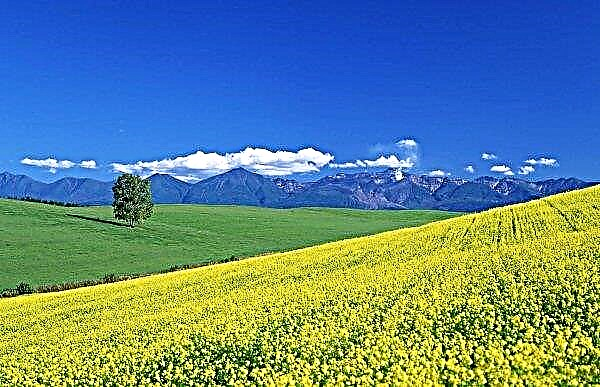Juniper Gold Cohn stands out for its unusual golden color, which changes in different seasons of the year. It stands out beautifully from other evergreen conifers. This variety is also popular because of its good frost resistance and unpretentiousness in care. That is why this bush is often used for decorative purposes.
Botanical Description
Juniper Gold Con (Juniperus communis Gold Cone) - coniferous shrub with a narrow dense crown in the form of an elongated cone or column. This variety was obtained by breeding by breeders from Germany. It belongs to the species of common juniper from the Cypress family. Reaches a height of up to 2 m, and in width - up to 0.5 m. The bush has erect and vertical shoots. The root system is located deep enough, but has a not very ramified system. This juniper has a small increase - only 10-12 cm per year.

In spring, young needle needles are painted in yellow-golden color.. During the summer period, the coniferous cover acquires a green color with a golden hue. In the cold season, the juniper bush becomes bronze.
The bush gives fruits in the form of cone-shaped round berries. Fruiting occurs in late summer. Fruits from ripening from green gradually turn blue-black. Ripe cones have a wax coating and are not toxic.
Did you know? Juniper cones are used in cooking as a spice for the preparation of game and fat red meat, smoked meats. Beer is brewed with them, and the distillery industry makes gin and juniper vodka with them.
The plant tolerates a haircut and can withstand frosts down to -40 ° C.
Landing
In order for the juniper ordinary Gold Coon to take root well in your area, you should correctly choose a seedling and a place for it. A young plant must be prepared for planting and create the best conditions for it.
Video: Planting and caring for juniper
Seedling preparation
Planting material must be purchased from reputable suppliers. Best of all - in specialized nurseries. For planting, you should choose seedlings 2-3 years old. More adult specimens will find it difficult to take root in a new place. As a rule, seedlings have a height of 15–30 cm and a crown of 10–20 cm.
When buying planting material, attention should be paid to the following points:
- The root system should be well developed and not have any damage. The roots are required to fill the entire container in which the bush is located.
- On the trunk should not be observed cracks, wounds and signs of disease.
- The shoots of a young seedling must be resilient and not break with a slight bend.
- White cotton-like formations should not be detected in the region of the growth point, as this indicates that the planting material is of poor quality.
- The coniferous cover must have a uniform color.
 Before planting, the dried needles at the base are removed from a young bush. To planting material better adapted to a new place, on the eve of planting, the roots should be placed in a solution with the addition of a root growth stimulator
Before planting, the dried needles at the base are removed from a young bush. To planting material better adapted to a new place, on the eve of planting, the roots should be placed in a solution with the addition of a root growth stimulator
Site selection and preparation
This plant culture prefers well-lit places that are well protected from gusts of wind.
Gold Cohn prefers light alkaline soils. If the soil is sufficiently dense and heavy, then sand should be added to it and take care of the drainage layer. Groundwater should not come close to the ground level, since this plant crop does not tolerate waterlogging and stagnation of water.
Important! In the shaded areas, the juniper Gold Cohn begins to lose its golden color, and the needles turn green. At the same time, the crown becomes rare and not aesthetic.
Landing process
You need to plant juniper seedlings in spring or autumn. The landing pit is prepared in advance.
The landing process itself occurs in the following sequence:
- First, they dig a planting hole, which in terms of parameters should be larger than the root system of the seedling. Typically, the dimensions are 0.6 × 0.6 m.
- A drainage layer of crushed stone or broken brick of 15-17 cm is placed at the bottom.
- Prepare a nutritious soil mixture. To do this, mix peat, turf land and sand in a ratio of 2/1/1. For additional nutrition, you can throw a handful of mineral fertilizers.
- If the soil has an acid reaction, then dolomite flour or slaked lime is thrown into the soil mixture.
- The earth is abundantly moistened.
- Two weeks later, planting material is planted. By this time, the prepared soil in the pit will settle.
- The prepared seedling is placed in the recess, gently spreading the roots.
- Then the bush is covered with earth, rammed it so that there are no voids.
- Spend abundant watering.
After planting, it is recommended to mulch the area around the seedling. In case of group planting, the interval between seedlings must be at least 1 m.
 It is necessary to make sure that the root neck of the juniper seedling is located at the level of the soil
It is necessary to make sure that the root neck of the juniper seedling is located at the level of the soil
Juniper Care
In order for the juniper to please with its dense crown and beautiful color, it is necessary for him to ensure proper care. It is especially important to pay attention to the plant in the first two years after planting, when the plant takes root in a new place. An adult plant is quite unpretentious.
Watering
Moisturizing is especially necessary for young plantings. In dry weather, watering is done every 2 weeks.. Older specimens are watered once a month. Do not forget that juniper does not like waterlogging.

This plant crop responds well to irrigation by irrigation. This procedure cleanses needles from dust and dirt. Moreover, the plant culture after it emits a pleasant aroma that positively affects the human respiratory system and purifies the air.
Important! Such watering is best done in the early morning or in the evening to avoid sunburn from drops of water on the needles.
Top dressing
This plant crop is undemanding to top dressing, can grow on poor soils. But, in order for the bush to please with a lush and dense crown, nitrogen-containing fertilizers must be applied in spring. In the summer, fertilizing containing phosphorus is needed. In the fall, potash fertilizers are used, which will prepare the juniper for the winter period. If Gold Cohn grows on poor soil, then you should use organic matter - compost or humus.
Video: Fertilizers for conifers
Loosening and mulching
The area around the bush must be loosened regularly. This will improve the flow of air, nutrients and moisture to the root system. In this case, weeds should be disposed of. So that the earth does not dry out, and the weed grass does not grow actively, it is recommended to mulch the trunk section. Peat, compost, straw, needles, sawdust are well suited as mulch.

Pruning
Adult instances of this variety should be cut in early spring. It is absolutely necessary to carry out sanitary pruning - to remove dried needles, as well as frozen, broken and diseased branches.
In order for the bush to have a beautiful crown, it is necessary to carry out forming pruning. The crown will be more magnificent and thicker if the shoots are shortened.
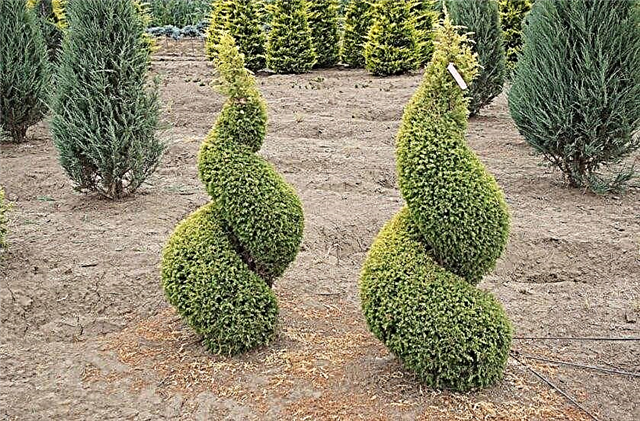
Winter preparations
This juniper variety has high frost resistance and does not need special shelter. In winter, so that the branches of a young seedling do not break under the weight of snowfall, they need to be tied to each other with a rope.
In early spring, the danger is the first active rays of the sun. During this period, young seedlings are recommended to cover with light covering material of white color, which allows air to pass through. This will prevent burns. Shelter is removed when the temperature in the daytime is reached at + 9 ... + 10 ° С.
Did you know? The cones of juniper ordinary have a diuretic, disinfectant, choleretic effect, remove sputum and improve digestion. But they are contraindicated in case of kidney inflammation.
Possible diseases and pests
Adult instances of juniper Gold Con ordinary enough resistant to various diseases and pests. But only planted seedlings are subject to such troubles. The most common are fungal diseases.
Of the pests of young bushes, the following insects are dangerous:
- Pine moth affects the needles and young branches.
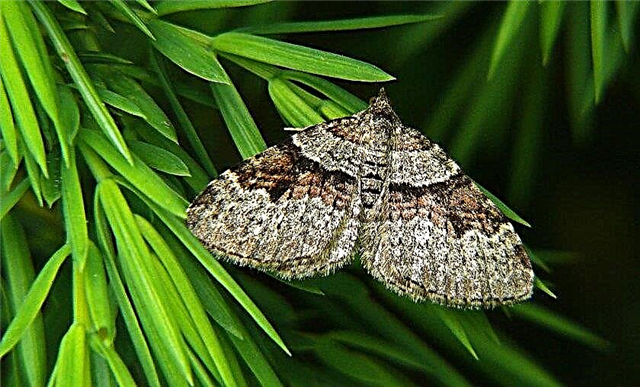
- Mealybug. This pest feeds on young shoots and is a carrier of soot fungus. Insecticides (“Aktara”) are used for control and prevention.
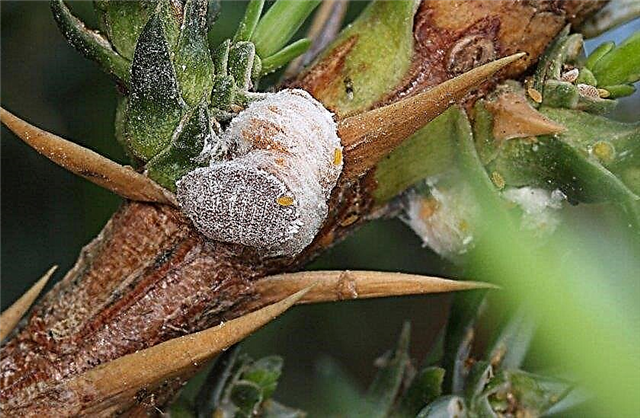
This plant crop does not tolerate waterlogging.
Rainy weather, violation of agricultural cultivation techniques (inappropriate moist soil, excessive watering, etc.) can cause the appearance of such fungal diseases:
- Fusarium. This disease is detected by redness of the coniferous cover on the shoots from above. The needles begin to fall, exposing the sites.

- Rust. It is identified by the appearance of many orange pustules. Gradually, the fungus moves to the trunk, causing a thickening and cracking of the bark.
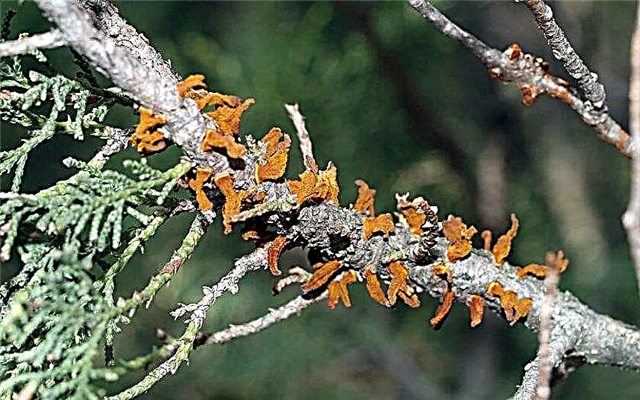
At the first appearance of fungal diseases, the affected shoots are cut and disposed of (burned). The bushes are sprayed with Bordeaux liquid, copper sulfate or fungicidal preparations (Fitosporin-M, Fundazol). As a prevention in early spring, it is recommended to carry out the treatment with the above means.
Breeding methods
Common con juniper is usually propagated by seeds and cuttings. The most popular cuttings, as it completely preserves all the qualities of the mother plant.
Did you know? For many Finno-Ugric peoples, including those living in Russia, juniper is considered a sacred tree and is used for amulets. In ancient times, the branches of this plant were scattered along the road to the cemetery, so that the spirit of the deceased could find a way home.
Seeds are first stratified on the shelf of the refrigerator, and then sown, buried in nutrient soil by 2 cm. Planting on top is covered with a film to maintain high humidity and put in place with a temperature of + 23 ° C. Every day, the film is removed for ventilation for 15-30 minutes and humidity is controlled. After emergence, the container with them is transferred to a well-lit window. Young plants should be watered, not allowing the soil to dry out or waterlogging, and to feed. The grown plants dive into separate containers. Juniper seedlings are planted at a place chosen in the garden at the age of 2-3 years.
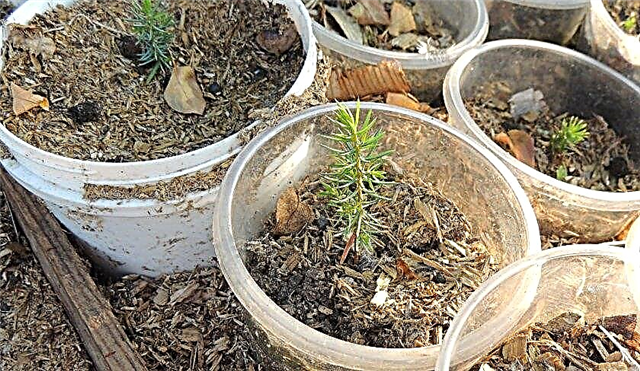
For cuttings in June, cuttings 5–10 cm in size are cut from the parent specimen. The bottom is immersed in a solution of a root stimulant, for example, in Kornevin. Then the planting material with the treated end is placed in a nutrient moistened substrate. Top planting with cuttings is covered with a jar to create a greenhouse effect. Periodically ventilate and moisturize as necessary. When rooting is successful, the jar is removed. A seedling is planted on a garden plot at the age of 2 years.

Use in landscape design
This cone-shaped, slow-growing coniferous plant, which has a non-standard yellow color, looks great in a variety of compositions. It is used for decorating park areas, patios and courtyards, gardens.
Jun Co Gold Con in landscape design can be used as follows:
- For growing hedges.
- In a single landing among a lawn or flower bed.
- In group compositions with other evergreen representatives. Combinations of plants of different shapes and colors look best. This variety can create an interesting color accent with its golden color.
- Among a rocky garden or on an alpine hill. The needles always look great against the background of stones and gravel.
- Like a container plant. Tanks with this compact plant can be placed on small platforms, balconies and loggias. The main thing is sufficient lighting.
- From it you can also form a bonsai.
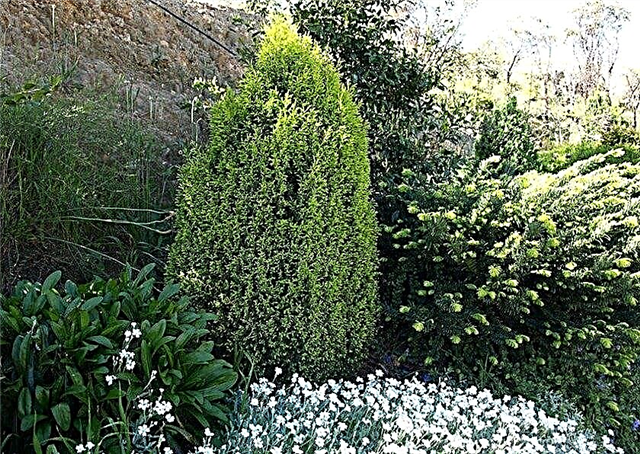
Juniper Gold Cohn slowly grows and grows in a narrow-conical bush of yellow color. This is a great plant for decorating a garden plot, especially with a lack of land. Young plants should organize careful care in their early years.





